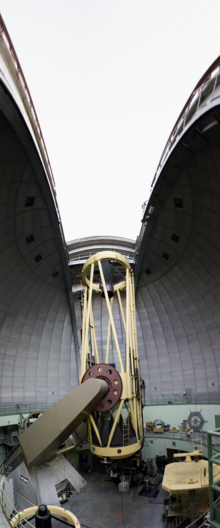C. Donald Shane telescope

C. Donald Shane 3m telescope at the Lick observatory on Mt. Hamilton, San Jose, California - as seen from inside the dome.
|
|
| Coordinates | 37°20′35″N 121°38′14″W / 37.343036°N 121.637136°WCoordinates: 37°20′35″N 121°38′14″W / 37.343036°N 121.637136°W |
|---|---|
| Website | www |
|
[]
|
|
The C. Donald Shane telescope is a 120-inch (3.0-meter) reflecting telescope located at the Lick Observatory in San Jose, California. It was named after astronomer C. Donald Shane in 1978, who led the effort to acquire the necessary funds from the California Legislature, and who then oversaw the telescope's construction. It is the largest and most powerful telescope at the Lick Observatory, and was the second-largest telescope in the world when it was commissioned in 1959.
The Shane's mirror started as a 10,000-pound Corning Labs glass test blank for the Palomar Observatory's 200-inch (5-m) Hale telescope (in north San Diego County, California), but was sold below cost ($50,000) by Caltech to the Lick Observatory. It was then transported to Mount Hamilton, where the blank was ground and polished by the observatory.
The telescope can be used with three different focal stations: wide field prime focus, coudé focus for high precision spectroscopy, or the intermediate cassegrain focus.
In the Shane dome there is a laser, whose light is sometimes visible with the naked eye, that the observatory beams from the Shane telescope into the night sky. The laser is part of the Lick Adaptive Optics (LAO) program, a joint project of the Lick Observatory and the Lawrence Livermore National Laboratory. LAO corrects for atmospheric turbulence either by using a natural guide star or by creating a sodium laser guide star, and using the observed motion of the guide star to direct distortion of a deformable mirror hundreds of times each second. The system produces images that are nearly equivalent to those obtained from space-based telescopes. Adaptive optics using natural guide stars has been in development since 1996, and using laser guide stars since 2001. Similar laser adaptive optics systems based on LAO have been installed on the University of California's two Keck telescopes in Hawaii.
...
Wikipedia
